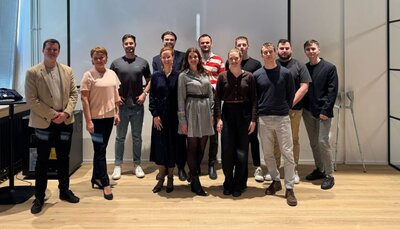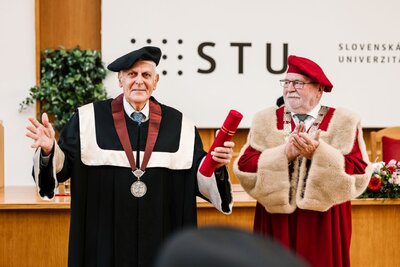 Faculty of Electrical Engineering and Information Technology
Faculty of Electrical Engineering and Information Technology
Department/Institute: Institute of Nuclear and Physical Engineering
Contact person: prof. Ing. Marcel Miglierini, DrSc., Ing. Július Dekan, PhD.
Contact: +421 2 6029 1167, +421 2 6029 1832
e-mail: marcel.miglierini@stuba.sk, julius.dekan@stuba.sk
Description:
Mössbauer spectroscopy is a nondestructive method with broad diagnostic potential, applicable for any material containing iron. It allows precise phase analysis of the material, as well as identification of iron atoms in various crystallographic orientations. Mössbauer spectroscopy can be applied in the field of metallic materials, alloys, steels and magnetic materials. Mössbauer spectroscopy allows precise identification of iron oxides and this capability is useful in the field of mineralogy, geology, materials for magnetic recording and corrosion studies. It is useful also for analysis of unordered (amorphous) noncrystalline matter. We are also experienced in the field of archaeology, biology, chemistry, thin films as well as mineralogy including meteorites.
Measurements using the MS are not so demanding on the sample preparation. Usually, few milligrams of powder sample or thin foil is sufficient for basic analytic purposes.
The MS laboratory also includes MS spectrometer, which is capable of simultaneous measurements in TMS, CEMS as well as CXMS mode (TMS=Transmission Mössbauer Spectrometry, CEMS=Conversion Electron Mössbauer Spectrometry, CXMS=Conversion X-ray Mössbauer Spectrometry). The TMS provides information about the bulk of the sample, while CEMS and CXMS scans subsurface layers up to 200 nm and 1000 nm, respectively. Therefore, we can obtain information about the bulk and surface states simultaneously.
Actual projects:
1. COST Action MP0903 Nanoalloys as Advanced Materials: from Structure to Properties and Applications (NANOALLOY), 2010-2014
2. IAEA Coordinated Research Project No. F1204: Utilization of Accelerator-based real-time methods in investigation of materials with high technological importance, 2013-2015
3. Structural and magnetic properties of metallic glasses irradiated by ions, bilateral project APVV Slovakia-Poland SK-PL-0032-12, 2013-2014
4. Structural forms of iron deposits in organisms, bilateral project APVV Slovakia-Bohemia SK-CZ-2013-0042, 2014-2015
5. Nanocrystalline complexes of iron in biological tissues, VEGA 1/0220/12, 2012-2015
6. Radiation resistance of nanocrystalline metallic alloys to different types of radiation, VEGA 1/0286/12, 2012-2014
7. Isotopic examination of Košice meteorite and similar H type chondrites, VEGA 1/0770/11, 2011-2014
8. Evaluation of radiation resistance of ODS steels for fusion and fission technologies, VEGA 1/0366/12, 2012-2015
9. Research of Slovak meteorites, APVV-0516-10, 2010-2014
10. Centre of competence for new materials and advanced technology and energetics, ITMS code: 26240220073, 2011-2014
Publications (2010-2013):
1. Boča R., Kopáni M., Miglierini M., Čaplovičová M., Mrázová V. and Dlháň Ľ.: Magnetic and Non-Magnetic Iron-Oxide Deposits in Basal Ganglia, in: Horizons in Neuroscience Research, Vol. 12 (eds. Andees Costa and Eugenio Villalba), Nova Science Publishers, Inc., New York, 2013, ISBN: 978-1-62618-964-5, p. 135-213.
2. Boča R., Dlháň Ľ., Kopáni M., Miglierini M., Mrázová V. and Čaplovičová M.: Deposits of iron oxides in the human spleen, Polyhedron 66 (2013) 65-69.
3. Miglierini M.: Structural transformations in metallic glasses, Acta Electrotech. et Informatica 13 (2013) 12-15.
4. Miglierini M., Prochazka V., Stankov S., Svec Sr. P., Zajac M., Kohout J., Lancok A., Janickovic D, and Svec P.: Crystallization kinetics of nanocrystalline alloys revealed by in-situ nuclear forward scattering of synchrotron radiation, Phys. Rev. B 86 (2012) 020202(R).
5. Osacký M., Šucha V., Miglierini M. and Madejová J.: Reaction of bentonites with pyrite concentrate after wetting and drying cycles at 80°C, Clay Minerals 47 (2012) 465-479.
6. Klačanová K., Fodran P., Šimon P., Rapta P., Boča R., Jorík V., Miglierini M., Kolek K., and Čaplovič Ľ.: Formation of Fe(0)-Nanoparticles via Reduction of Fe(II) Compounds by Amino Acids and Their Subsequent Oxidation to Iron Oxides, Journal of Chemistry, vol. 2013, Article ID 961629, 10 pages, 2013.
7. Miglierini M., Kohout J., Lančok A. and Šafářová K.: Magnetic Hyperfine Fields of NANOPERM Alloys, Acta Phys. Pol. A 121 (2012) 1263-65.
8. Miglierini M., Hatala T., Frydrych J., Šafářová K.: Surface crystallization of Co-containing NANOPERM-type alloys, Hyperfine Int. 205 (2012) 125-128.
9. Hasiak M., Miglierini M., Lukiewski M. and Kaleta J.: Microstructure, Magnetic Properties and Applications of Co-rich HITPERM-type Amorphous Alloys, IEEE Trans. Magn. 48 (2012) 1665-1668.
10. Bačík P., Ozdín D., Miglierini M., Kardošová P., Pentrák M., Haloda J.: Crystallochemical effects of heat treatment on Fe-dominant tourmalines from Dolni Bory (Czech Republic) and Vlachovo (Slovakia), Phys. Chem. Minerals 38 (2011) 599-611.
11. Miglierini M., Lančok A. and Kohout J.: Hyperfine fields in nanocrystalline Fe-Zr-B probed by 57Fe nuclear magnetic resonance spectroscopy, Appl. Phys. Lett. 96 (2010) 211902.
12. Stankov S., Miglierini M., Chumakov A. I., Sergueev I., Yue Y. Z., Sepiol B., Svec P., Hu L. and Rüffer R.: Vibrational thermodynamics of NANOPERM nanocrystalline alloy from nuclear inelastic scattering, Phys. Rev. B 82 (2010) 144301.
13. Haehnel V., Fähler S., Schaaf P., Miglierini M., Mickel C., Schultz L. and Schlörb H.: Towards smooth and pure iron nanowires grown by electrodeposition in self-organized alumina membranes, Acta Materialia 58 (2010) 2330-2337.
14. Švec P., Miglierini M., Dekan J., Turčanová J., Vlasák G., Škorvánek I., Janičkovič D., Švec Sr. P.: Magnetic transactions in Hitperm-type Fe-Ni-Nb-B system, IEEE Trans. Magn. 46 (2010) 412-415.
15. Miglierini M., Lančok A. and Pavlovič M.: CEMS Studies of Structural Modifications of Metallic Glasses by Ion Bombardment, The Physics of Metals and Metallography 109 (2010) 469-474.
Cooperation with domestic organizations:
1. Institute of Physics, Slovak Academy of Sciences, Bratislava
2. Faculty of Chemical and Food Technology, Slovak University of Technology in Bratislava
3. Faculty of Medicine, Comenius University in Bratislava
4. Faculty of Natural Sciences, Comenius University in Bratislava
5. Faculty of Mathematics, Physics and Informatics, Comenius University in Bratislava
6. Faculty of Natural Sciences, University of St. Cyril and Methodius in Trnava
7. Geological Institute, Slovak Academy of Sciences, Bratislava
Cooperation with foreign organizations:
1. Wroclaw University of Technology, Wroclaw, Poland
2. TU Ilmenau, Germany
3. Karlsruhe Institute of Technology, Eggenstein-Leopoldshafen, Germany
4. European Synchrotron Radiation Facility, Grenoble, France
5. Faculty of Science, Palacký University Olomouc, Czech republic
6. Faculty of Mathematics and Physics, Charles University in Prague, Czech republic
7. Institute of Inorganic Chemistry AS CR, Husinec-Řež, Czech republic
Photos:

Fig. 1: Mössbauer spectrometer in transmission geometry, room temperature measurement.

Fig. 2: Mössbauer spectrometer capable of simultaneous TMS, CEMS and CXMS measurements. (TMS=Transmission Mössbauer Spectrometry, CEMS=Conversion Electron Mössbauer Spectrometry, CXMS=Conversion X-ray Mössbauer Spectrometry).

Fig. 3: Detail of TMS/CEMS/CXMS Mössbauer spectrometer.



